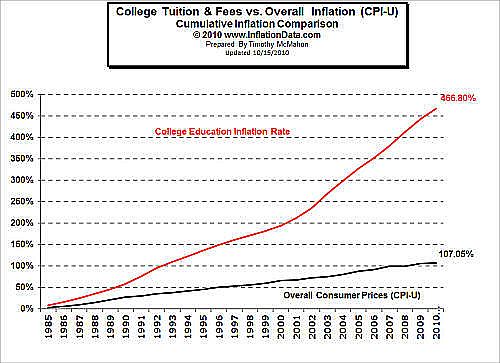Much has been said of the increasing gap between rich and poor. But the past quarter-century has also seen a greatly increased gap between people under 35 and people over 65. A newly released report from Pew Social Trends highlights this: between 1984 and 2009, the average net worth of an under 35 actually fell by 68% (despite the massive booms that are meant to have taken place during that time). The average net worth of an over 65 increased by 42%.
To put it another way, the average American over 65 in 1984 had 10 times the net worth of an American under 35. In 2009, he or she had 47 times the net worth of an American under 35. The figures were not much different in 2005, before the financial crisis began, although the effect of the crisis has been to increase the gap further in percentage terms. See the handy-dandy charts after the jump.
What are the primary reasons for this increased gap?
First and foremost is the humble house. Or not the so humble house, penthouse, condo, or whatever.
Guess who got to buy cheap houses on cheap credit. Guess who, with the growing equity in their houses, got to take out loans to invest in more property which they could pay off using the rent they got from younger generations, letting them bid on more properties, driving prices ever higher and out of reach of the youngs. Right.
And in a double whammy, when property prices fell in the financial crisis, who had already paid off their houses and who got caught out having bought at the top of the market, if they’d managed to buy at all? Right.
To quote Pew, “Housing has been the main driver of these divergent wealth trends. Rising home equity has been the linchpin of the higher wealth of older households in 2009 compared with their counterparts in 1984.” “The median net worth of all U.S. households increased to $71,635 in 2009 from $65,293 in 1984, a gain of 10%. However, if home equity is excluded, median net worth shows an 11% decline. Median net worth excluding home equity decreased to $13,899 in 2009 from $15,556 in 1984.”
Whatever wealth was created in realityland during the past quarter century, and not just on paper which was torn up when the debt bubble burst, ended up in property owned by over 65s.
What else is there?
Well, as noted in a chart in momof3 and GI’s recent article on the cost of education right here on Crasstalk, the cost of education has taken off like the proverbial rocket while the necessity of getting that education to get a job has increased. A footnote to the Pew report claims that graduates who received a bachelor’s degree in 2008 borrowed on average 50% more (in inflation-adjusted dollars) than their counterparts in 1996.
That means rapidly increasing student loan debt on the people who already have the least ability to quickly pay it down (especially in the last few years, as this same age bracket has been hit hardest by unemployment), which reduces those young people’s abilities to do things like get into the property market, obtain an investment portfolio or, crucially, start their own businesses.
It looks like the Youngs are going to be the Poors until the over 65s die and the Youngs (by then not so young) inherit ALL THE THINGS, as we say around here.
It will be interesting to see if the Millenials and Gen Xers in America (and elsewhere, for that matter) are prepared to tip over the apple cart of economic policies which have treated property values and capital gains as the most important things in society, and instead focus on affordability in housing and education to reduce the gaps between young and old, rich and poor, to something more sensible? In that respect, it is heartening to see President Obama announce a policy on student loans. We can only hope that a re-elected Obama, hopefully with a less obstructionist Congress, can continue with policies to bridge the gap after the next Presidential election.
(Cash photo via Images_Of_Money @ flickr)
(Charts via Pew Social Trends)



